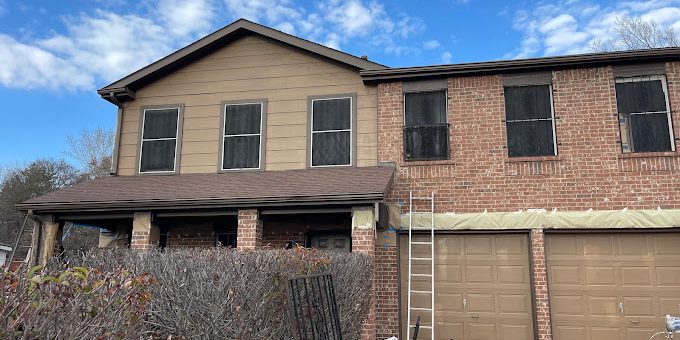Enhancing your home’s exterior with a fresh coat of paint is one of the most impactful ways to improve curb appeal and protect your investment. In Allen, Texas, where weather conditions can be unpredictable, maintaining the exterior of your home is essential for long-term durability and beauty. Whether you’re considering a DIY project or hiring professionals, understanding the best practices for exterior painting will ensure stunning results that last.
Key Takeaway: A successful exterior painting project requires proper preparation, high-quality materials, and a focus on long-lasting protection for your home.
Choosing the Right Exterior Paint
Understanding Paint Types
Selecting the appropriate paint type is critical. For exterior applications, you need paint designed to withstand harsh UV rays, moisture, and temperature changes. Acrylic latex paints are popular for their durability and ease of application, while oil-based paints offer a smooth finish and strong adhesion, ideal for areas exposed to heavy wear.
Considering Color Impact
Colors play a big role in curb appeal. Lighter shades reflect sunlight, keeping homes cooler in summer, while darker hues offer a bold, elegant look. In Allen, Texas, where the sun shines intensely, opting for UV-resistant colors can prevent fading and maintain vibrancy.
Evaluating Paint Finishes
Choosing between matte, satin, and gloss finishes depends on the desired aesthetic and maintenance level. Satin is often preferred for exteriors as it offers a subtle sheen and easy cleaning, while gloss works well for doors and trim for a striking contrast.
Preparing the Surface for a Perfect Finish
Cleaning and Power Washing
Before applying any paint, the surface must be spotless. Dirt, mildew, and chalking can prevent adhesion, leading to premature peeling. Power washing your home’s exterior is an effective way to ensure a clean foundation for painting.
Repairing and Sanding
Damaged siding, cracks, or peeling paint must be addressed. This includes patching holes and sanding rough spots to create a smooth surface. For homes with interior damage needing attention before exterior work, professional drywall services can ensure a seamless repair.
Priming for Adhesion
Primer is crucial for achieving a strong bond and long-lasting finish. It seals porous surfaces, covers stains, and provides an even base for paint application. Always use a primer that matches your chosen paint type for optimal results.
Weather and Timing Considerations
Painting in the Right Season
In Allen, Texas, spring and early fall are ideal for exterior painting due to moderate temperatures and lower humidity. Avoid painting during peak summer heat or rainy days to prevent issues like blistering or streaking.
Monitoring Humidity Levels
High humidity can delay drying times and affect paint adhesion. Always check the weather forecast and aim for days with humidity levels below 70% for the best outcome.
Working with Daylight
Start your project early in the day to maximize natural light and allow sufficient drying time between coats. Painting in shaded areas first prevents lap marks as sunlight shifts.
Techniques for Professional Results
Applying Even Coats
Use long, smooth strokes with a high-quality brush or roller. For large surfaces, spraying can speed up the process, but back-rolling ensures proper coverage and adhesion.
Focusing on Details
Trim, shutters, and doors require precision. Consider using a smaller angled brush for these areas to achieve a clean, polished look without drips or uneven lines.
Protecting Surrounding Areas
Cover landscaping, windows, and walkways with drop cloths or plastic sheeting. This prevents accidental splatters and keeps the project area neat and safe.
Maintenance After Painting
Regular Cleaning
Once the paint has cured, gently wash the exterior at least once a year to remove dirt and pollutants. This simple step keeps the surface fresh and extends the lifespan of your paint job.
Inspecting for Wear
Look for signs of peeling, cracking, or fading, especially on sun-exposed areas. Touch-ups prevent minor issues from becoming costly repairs and maintain your home’s pristine appearance.
Sealing and Protecting
Adding a protective sealant to painted surfaces can further shield your home from moisture and sun damage, especially if you have features like decks or fences that require special care. For example, services such as deck staining and sealing provide an extra layer of durability and elegance.
Answering Common Questions
What is the best paint for Texas weather? Acrylic latex paint is typically the best choice for Texas climates because it offers superior flexibility and resistance to both moisture and UV rays.
How often should I repaint my home’s exterior? Most homes in Allen need a new coat of paint every 7–10 years, depending on exposure, paint quality, and maintenance practices.
Can I paint over old peeling paint? No, peeling paint must be scraped and sanded before applying new paint. Skipping this step can lead to adhesion problems and a shorter lifespan for your new paint job.
The Role of Surface Preparation
Surface preparation determines the longevity and quality of the finish. Skipping cleaning or sanding can result in bubbling or flaking, even with premium paints.
How Color Choices Affect Curb Appeal
Colors set the tone for your home’s exterior. Warm neutrals can make a property feel welcoming, while bold shades add character. Pairing the right hues with professional cabinet painting indoors creates harmony throughout your home.
Why Professional Help Makes a Difference
While DIY is tempting, exterior painting is time-consuming and requires expertise. Professionals bring the right tools, skills, and techniques to deliver a flawless finish. For more advanced projects, like wallpaper installation or exterior transformations, MJ Workforce Solutions ensures top-notch results tailored to your home’s unique needs.







